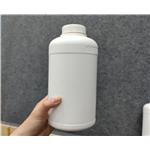Synthesis
1-Octyne (7.5 g) and formic acid (100 mL) were heated in an oil bath at 100 ºC until all starting material was consumed. The progress of the reaction was monitored by GC analysis of the reaction solution. Quantitative GC analysis at the end of the reaction (6 h) indicated 92% yield of 2-octanone. The cooled reaction mixture was taken up with CH2Cl2 (170 mL), and the solution was washed with water, sodium carbonate solution, and water, dried over MgSO4, and evaporated in vacuo. The residue was distilled (bp 171–173 ºC) to give 2-octanone (7.42 g, 85%).

Reference: Menashe, N.; Reshef, D.; Shvo, Y. J. Org. Chem. 1991, 56, 2912–2914.
References
[1]Bangs, William E., and G. A. Reineccius. "Influence of Dryer In feed Matrices on the Retention of Volatile Flavor Compounds During Spray Drying." Journal of Food Science 47.1(1982):254-259. Kida, T, et al. "New cleavable surfactants derived from glucono-1,5-lactone. " Journal of the American Oil Chemists’ Society 71.7(1994):705-710.
[2]Tan, Guan Huat, and Lukman Bola Abdulra'uf. "Recent developments and applications of microextraction techniques for the analysis of pesticide residues in fruits and vegetables." Pesticides-Recent Trends in Pesticide Residue Assay. InTech, 2012.
Description
2-Octanone has a floral and bitter, green, fruity (unripe apple) odor
with a bitter camphoraceous taste. May be synthesized by the
oxidation of methyl hexyl carbinol with K2Cr2O7 and sulfuric acid;
also by oxidation of 2-octanol over zinc oxide at 330 - 340°C.
Chemical Properties
2-Octanone has a floral and bitter, green, fruity (unripe apple) odor and bitter, camphoraceous taste. Insoluble in water; solublein alcohol, hydrocarbons, ether, esters, etc. Com-bustible.
Occurrence
Reported found in apple, apricot, banana, cranberry, grape, raisin, papaya, peach, raspberry, strawberry, leek,
peas, clove, wheat bread, many cheeses, butter, milk, cooked egg, yogurt, caviar, fatty fish, meats, beer, hop oil beer, cognac, rum,
grape wines, cocoa, coffee, tea, roasted filberts and peanuts, pecans, potato chips, oats, soybean, olive, beans, walnut, trassi, mushroom,
fig, rice, buckwheat, quince, sweet corn, corn oil, malt, wort, krill, Bourbon vanilla, mountain papaya, shrimp, crab, crayfish,
clam, truffle, maté and mastic gum oil.
Uses
2-Octanone may be used as an analytical reference standard for the quantification of the analyte in sugar-cane spirits and rum samples and whey protein concentrate using chromatography based techniques.
Uses
2-Octanone is used in perfumes, high-boiling solvent, especially for epoxy resin coatings and in leather finishes. It is used in flavoring, odorant. It can act as antiblushing agent for nitrocellulose lacquers.
Preparation
By oxidation of methyl hexyl carbinol with K2Cr2O7 and sulfuric acid; also by oxidation of 2-octanol over zinc oxide at
330 to 340°C.
Production Methods
2-Octanone can be produced by oxidation of methyl hexyl
carbinol, 2-octanol, or 1-octene or by reductive condensation
of acetone with pentanol. Commercial samples can have a
purity of 98%.
Definition
ChEBI: A methyl ketone that is octane substituted by an oxo group at position 2.
Aroma threshold values
Detection: 41 to 62 ppb
Taste threshold values
Taste characteristics at 10 ppm: dairy, waxy, cheese, woody, mushroom and yeast.
General Description
2-Octanone is a volatile flavor compound reported to be found in blue cheese, acerola fruit, blue crab and cray fish.
Industrial uses
Methyl n-hexyl ketone is used as solvent for vinyl compounds and dyes and is
suitable for dispersing dyes in light-weight petroleum oils for newsprint inks.
Safety Profile
Poison by ingestion.
Moderately toxic by intraperitoned route. A
sktn irritant. Flammable liquid when
exposed to heat, flame, or oxidizers. To
fight fire, use foam, alcohol foam. When
heated to decomposition it emits acrid
smoke and irritating fumes. See also
ETHER and KETONES.
Toxics Screening Level
The initial threshold screening level (ITSL) for 2-octanon~ (also known as methyl hexyl ketone) is being established at 7 μg/m3 based on an annual averaging time.






